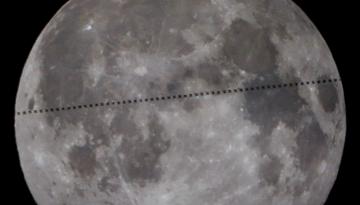Speculation is rife after NASA on Thursday said it has made an "exciting new discovery" about the moon.
The space agency was tight-lipped about what it could be, only saying it would "support deep space exploration" - prompting jokes on social media NASA had confirmed the moon is in fact made of cheese or had been "hexed" by teenage witches.
Duncan Steel, a space scientist formerly of NASA and the European Space Agency who currently lives in Nelson, told Newshub it's likely to be in relation to water.
A Soviet probe in the 1970s detected trace amounts of water on the lunar surface, and in the 1990s a NASA probe called Clementine - which Dr Steel was involved with - detected enough near the moon's poles to perhaps support a manned colony and provide fuel for future rocket missions.
Later missions added to the weight of evidence, and in 2018 NASA said it was beyond doubt there was water on the moon.
"We are mainly interested in water on the moon due to the need for it for human presence there: we would use the water for the usual purposes (drinking, showering), but also H2O is obviously a good source of oxygen, which we need to breathe," said Dr Steel.
"On top of that, the H2O could be split so as to make rocket propellant."
The reveal is scheduled for 5am on Tuesday (NZ time). Dr Steel pointed to clues in NASA's statement on Thursday the discovery will involve water.
Firstly, the discovery was made using the Stratospheric Observatory for Infrared Astronomy (SOFIA) - a Boeing 747 which flies in the stratosphere with an onboard telescope, above most of the atmosphere's water vapour.
The second clue is the four NASA staff who'll be presenting the discovery on Tuesday - three managers and just one scientist, Casey Honniball - a postdoctoral fellow at NASA's Goddard Space Flight Center whose bio on the NASA site says she is currently studying "water at pyroclastic deposits on the Earth and Moon using new data sets and techniques".
Specifically, she's doing research into how much water is on the moon - trying to reconcile differences in measurements between remote sensing data and samples collected during the Apollo missions.
Prior to starting her postdoctoral research, Dr Honniball measured water levels on the moon using SOFIA and NASA's InfraRed Telescope Facility on Mauna Kea in Hawaii.
"An infrared telescope needs to be at high altitude so as to be above the main water vapour content of the atmosphere, because that H2O absorbs the very wavelengths you want to study," said Dr Steel, whose achievements in science saw a minor planet named after him.
"SOFIA takes a telescope even higher, up to 40,000 feet-plus, for basically the same reason: get above the water vapour so you can access the universe at infrared wavelengths."
SOFIA often spends the winter running missions from Christchurch Airport, taking advantage of the long nights and clear airspace around New Zealand.
"I anticipate that the discovery announcement will be all about water being mapped on the lunar surface," said Dr Steel. "Not liquid water, but water present as ice likely in the surface structure or as hydrated minerals. Either way, the focus will be: this is important for human exploration/establishing a scientific outpost there."
NASA plans to send humans back to the moon in 2024, including the first woman, as part of its Artemis programme. Mars is hoped to be next, sometime in the 2030s.
Dr Steel says the announcement is almost certainly not going to be regarding life on the moon - for that you need liquid water, which cannot exist in a vacuum.




